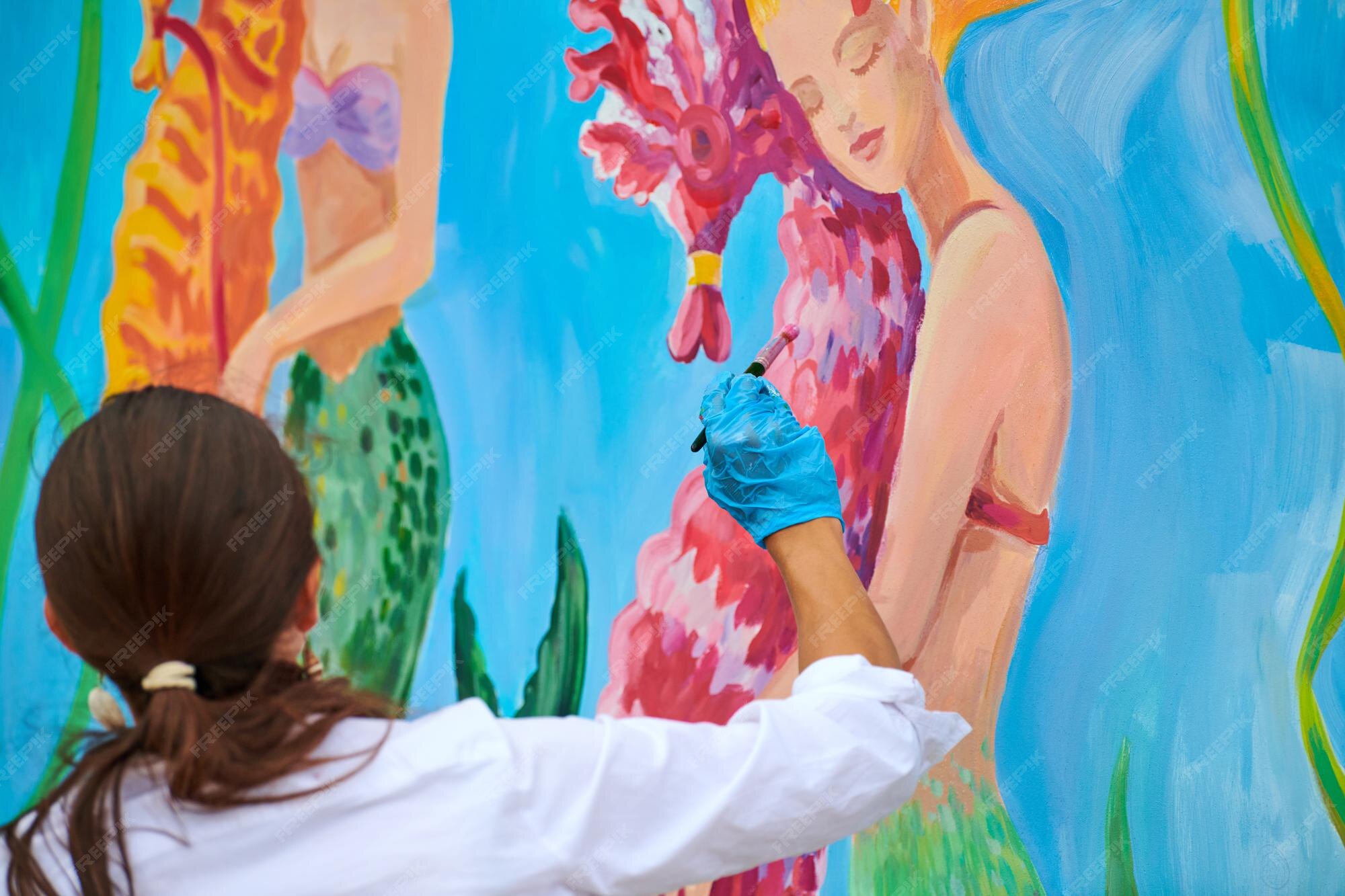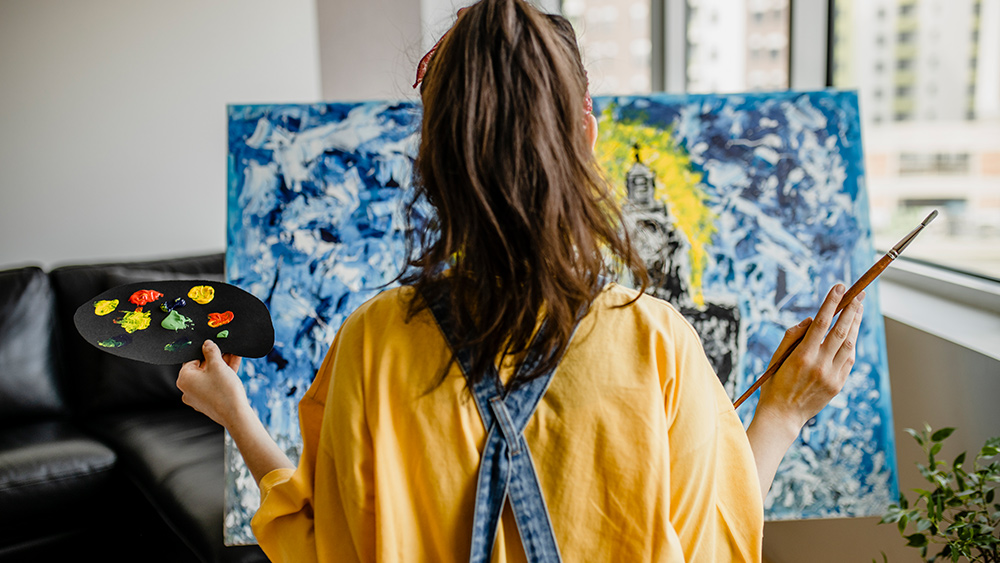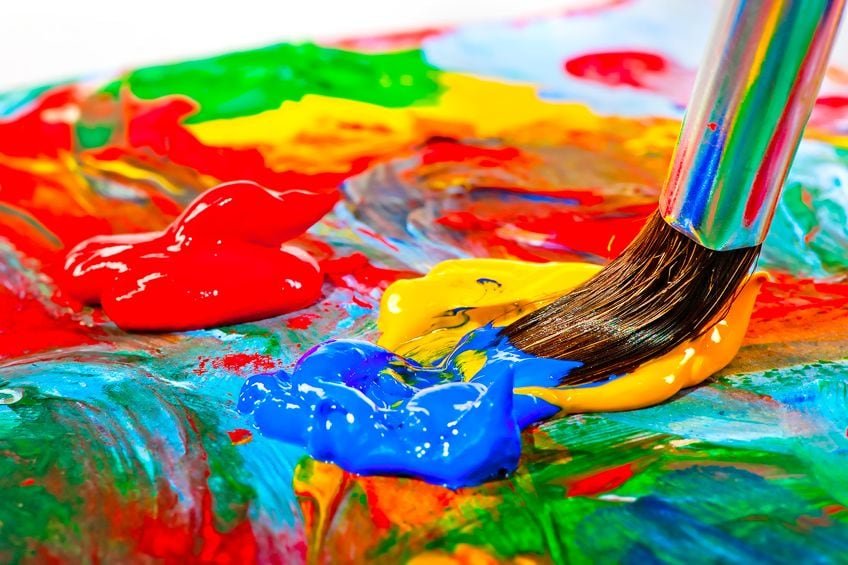When you are thinking about painting, acrylic paints are your best option. Acrylic paints are an affordable way to paint your home. But what is acrylic paint? And why should you use acrylic paints on your walls, furniture or artwork?
Acrylics are a type of paint that’s water-soluble and made from synthetic polymers. They’re used primarily for painting on canvas, but they can also be applied to other surfaces such as metal, wood, plastic, fabrics, shoes and walls.
This article will highlight the following ;
- What acrylic paint is made of
- Main types of acrylic paint
- The differences between Oil and Acrylic Paints
So, keep reading before your next art project.
Related Posts
Can You Use Acrylic Paint on Leather?
What Can You Paint With Acrylic Paint?
Can You Use Acrylic Paint on Glass?
What Are Acrylic Paints ?


Acrylic paint is a fast-drying, water-soluble paint made from pigment, binder, and water. It is used for artists’ paintings, commercial signage, and other artistic applications that require a highly versatile and durable coating.
Acrylic paint is also perfect for artists who want to work with a variety of materials, as it can be used on canvas, wood and other surfaces because they are water-based, meaning they are non-flammable and safe around children.
Talking of acrylic ingredients, acrylic paint consist of pigments suspended in an acrylic polymer emulsion.
These paints dry quickly when they come in contact with air, which makes them ideal for use on canvas or paper. They are also easy to clean up with soap and water after you’ve finished painting.
Related Post: Is Acrylic Paint Toxic?
What Is Acrylic Paint Made Of?
Acrylics are made from synthetic resins, which are derived from coal tar or oil distillates that are polymerized with other compounds.
The resulting compounds are then broken down into monomers that can be processed into acrylic resin. The most common resin used in acrylic paints is methyl methacrylate (MMA), although ethyl acrylate, butyl acrylate and propylene glycol diacrylate are also used.
Acrylic paints contain pigments that give them color and fillers that dilute the thick consistency of the resin. These pigment colors range from white to black and include blue, red, yellow, orange and green shades as well as white, black and brown colors.
Types of Acrylic Paint?
1. Opaque Acrylics
These are the most common types of acrylic paint. The word “opaque” means that light cannot pass through the paint layer, so these paints work well for covering up other colors.
They are also sometimes called heavy body acrylics because they have more pigment in them than other types of acrylics, which makes them great for creating solid blocks of color on the canvas.
This type of acrylic is often used as an alternative to oils because they dry faster, but they do not have the same level of control over brushstrokes as traditional oil painting do.
2. Transparent Acrylics
Transparent acrylics allow light to pass through their pigment layers and reflect back out of the canvas when you shine a light on it from behind.
This effect is similar to stained glass windows or stained glass lamp shades where light passes straight through but reflects off of each layer as it travels through the glass to create an iridescent effect. These types of paints are mostly recommended for beginner painters and artists.
What Are Acrylic Paints Used For?
Acrylic paints are used for a variety of projects in the home, including painting walls and furniture, creating murals on walls, making ceramic molds and casting resin jewellery. They also work well for children’s art projects because they are non-toxic and wash easily out of clothing and off hands.
The most popular paints for oil painting are artist grade oils which are suitable for both indoor and outdoor use. They can be applied straight from the tube or with a brush or roller depending on your preference.
Oil based products do not dry as quickly as acrylics so it takes longer to finish a project but they offer greater depth of color and more flexibility when it comes to blending colors together while they’re wet.
Related Post: Can You Use Acrylic Paint on Shoes?
How to Use Acrylic Paint?


Acrylic paints are one of the most versatile forms of art supplies on the market. They can be used for everything from painting small figurines to murals and even fine art paintings. One of the best things about acrylics is that they dry quickly, which means that you can experiment with different techniques without worrying about messing up your work too much.
However, if you’re new to using acrylics, it can be difficult to know how to apply them properly and get the results you want. Here are some tips to help you master this art;
1.Choose Your Colors Wisely
When choosing your colors, it’s important to pick ones that complement each other well. Acrylic paint dries quickly, so make sure that your color choices will blend well together once applied over each other.
2. Choose the Right Paint
Paints are sold in tubes or jars and come in a range of viscosities from thin to thick. If you want more control over your paintbrush strokes, choose a thinner consistency; if you want more coverage in fewer strokes, choose a thicker consistency.
3. Prep Your Surface
Acrylic paint will stick to most surfaces, but it works best on porous surfaces. The more porous the material, the better. If you’re painting a wall or canvas, prime the surface with gesso to ensure a smooth finish. If you’re working on paper or fabric, prep your surface by stretching it tightly over a board or other rigid backing and then stapling it down.
4. Have A palette knife
A palette knife is an essential tool for mixing and applying acrylic paint.
Acrylic paint comes in tubes and jars. You can mix colors together on your palette knife before applying them directly onto your canvas or paper. You’ll want to mix several colors together at once so you can achieve your perfect color combination.
To mix colors together, place some white acrylic paint onto your palette knife first, then add blue and yellow until you get the desired shade of green.
Note: You can also use one color at a time if you prefer or need more control over how each color mixes with others before applying them to your canvas or paper.
5.Use Water as a Medium
The best way to create a smooth surface on an acrylic painting is by using water as a medium between layers of paint (known as glazing). This allows you to build up layers of color without having them appear too thick or uneven in texture. The more layers of color you use, the more opaque your finished product will appear — but don’t overdo it!
6. Always Seal Your Work after Painting
When using acrylic paint, it’s important to seal your work after painting. Acrylic paint dries quickly, which means that if you don’t seal your work with an acrylic spray sealer or varnish within 24 hours of finishing, it will start to yellow over time. This is because the acrylic paint has not had time to cure properly; the longer it sits without being sealed, the more likely it is that the yellowing will occur.
Sealing your work is an important step to take when using acrylic paints because it prevents further yellowing and fading of the color into white or another color. It also makes cleaning up easier when you need to clean up excess paint from brushes or other tools.
Is Acrylic Paint Water Based?
Acrylic Paint is water-based?
Acrylics are good for beginners because they’re very forgiving when applied incorrectly -you can simply remove the paint with water (or use alcohol if you’re working on canvas or paper).
However, over time your brushstrokes may become visible due to the quick drying time of acrylics; this is called “dragging” or “feathering,” which will cause your artwork to lose its sharp edges and look less professional.
The biggest advantage to using acrylics is that they’re easy to clean up if you make a mistake or need to change something later on in the process.
You don’t have to wait for them to dry before removing them from your work surface because they dry almost instantly when applied onto a nonporous surface such as paper or canvas.
Related Post: Is Acrylic Paint Water-Based?
What Are the Differences Between Oil and Acrylic Paints?
Oil and acrylic paints are both used to create artwork. However, they have different characteristics which make them suitable for different types of painting.
Oil Paint
Oil paint is made by mixing pigments with a drying oil such as linseed or poppy seed oil.
The oil acts as the binder, holding the pigment together, and evaporates slowly over time to leave a hard surface. It also slows down the drying process, allowing for more time to work on the painting. The resulting paintings have a rich, thick texture that can be manipulated into many different effects.
However, this makes it difficult to undo mistakes because once it is dry it cannot be removed easily from the surface of the canvas without damaging it in some way.
Acrylic Paint
Acrylic paint is made by mixing pigments with water-based binders such as methyl methacrylate (MMA) or ethyl acrylate (EA). These binders dry quickly when exposed to air instead of evaporating slowly over time like oils do.
This makes them ideal for creating works on canvas because there is less chance that they will buckle or wrinkle when left out in humid conditions. Acrylic paints are also easy to clean up with just water and soap( Perfect for beginners).
What Is the Difference Between Watercolor and Acrylic Paint?


Watercolor paint is made up of pigment, water and sometimes a binder while acrylic paints are made of pigment, acrylic polymer emulsion and additional solvents.
Watercolors can also be diluted with water to create washes, while acrylics are not intended to be diluted. They are usually applied in thin layers and build up slowly over time to achieve an opaque finish.
In depth, watercolor paints contain pigments suspended in either transparent (water) or opaque (gelatin) media.
The pigment particles in both types of media are finely ground so that they will readily disperse in water or gelatine solution; however, the transparency of the medium affects how much light will pass through it, as does the amount of binder used for each particle size.
In contrast, acrylic paints contain finely ground pigments dispersed in a polymer emulsion that is solid at room temperature but changes its state when heated (i.e., melts) so that it can be brushed onto a surface or blended with other colors using an artist’s brush or palette knife.
The most significant difference between these two painting mediums is their drying properties: Watercolors dry quickly on the paper surface due to their high ratio of water content compared with acrylics which take longer
What Color is Acrylic Paint?
Acrylic paints come in a wide variety of colors, from pastels to bright hues. You can buy acrylic paints individually or in sets. The most common form of acrylic paint is tube paint, but you can also find it in cakes or jars.
The perfect balance between water and resin gives acrylic paint a unique characteristic that makes it ideal for artists who want to create works with rich color and depth.
The fact that it dries quickly allows artists to work with more layers than other media such as oil paints, which require more time between layers to dry properly.
Related Reading: Everything You Should Know About White Acrylic Paint
How Do You Use Acrylic Paint for the First Time? Tips For Beginners
Step One: Set Up Your Painting Station
It’s important to have a good workspace so that you can focus on your art and not get distracted by other things. If you have an easel, use it! If not, then put up a couple of chairs to make a makeshift one.
You’ll also need some sort of table or desk surface to work from. Make sure it’s large enough for all of your supplies, but not so big that you can’t reach everything easily.
You might want to consider having multiple tables or desks for different purposes. For example, you could have one for working with wet paint and another for dry paint and brushes.
Step Two: Practice and Experiment with Your Materials
Before you start creating your masterpiece, take some time to explore all the different ways that acrylics can be used creatively. Every artist has their own method of working with acrylics -try out different techniques until you find one that works best for you!
Some artists use palette knives instead of brushes, while others prefer using only their fingers as tools. Whatever works best for you is what should be used in your artwork!
Can I Mix Acrylics With Other Brands of Paint?
You can mix acrylics with other brands of paint, but the results will vary depending on the brands you are mixing. Some brands have similar chemical compositions, while others may not react well together.
If you want to try mixing them, test out how they interact before using them on a large scale project or in an important space.
Should I Prime My Canvas or Board Before Painting?


Priming your canvas or board is optional; however, it can help with adhesion and durability if done correctly.
If using a spray primer make sure that you hold the spray at least 12 inches away from your surface for even coverage (spray too close and you will get build up around edges).
Also make sure that your surface is clean and dry before priming
Frequently Asked Questions
How do I clean up after using acrylic paints?
Acrylics can be cleaned up with water and soap (no need for turpentine) or with a wet brush dipped in mineral spirits. If you use water, let the paint dry first before cleaning up so it doesn’t smear or lift off of your work surface. It’s best not to use alcohol-based products like rubbing alcohol because they will dissolve the paint film and leave streaks on your work surface.
Can acrylics be thinned with water?
Absolutely, but you can also thin them with a medium .
How do I clean my brushes?
Use soap and water or an appropriate brush cleaner if necessary. Avoid using strong solvents like turpentine for cleaning your brushes; these will ruin the bristles and cause them to break more easily in the future.
What is the difference between acrylic and oil paints?
Acrylics are water-based, while oils paints are glossy and oil-based. Acrylics dry faster and have a longer shelf life than oils, which makes them ideal for most projects.
Conclusion
So you’ve decided that you want to start using acrylic paints, but where do you begin?
Contrary to some people’s perception, acrylic paints are fairly similar to oil paints in terms of their composition.
As such, many of the same qualities of oils will also apply to these paints, including the need for an appropriate surface and the requirement that artwork be dry prior to framing or display.
REFERENCES
Acrylic paint
https://en.wikipedia.org/wiki/Acrylic_paint
Types of Watercolor Paint and How It’s Made
https://www.liveabout.com/types-of-watercolor-paint-4686969
What is Acrylic Paint?
https://study.com/academy/lesson/acrylic-painting-techniques-artists-examples.html
Acrylic Paint Characteristics and Advantages
https://www.liveabout.com/acrylic-paint-explained-2577362






